My product offerings are the result of customer requested designs. Most started out as a specific product for a specific customer. I am always open to new product suggestions. For example, I am anxious to buid a Trainwreck Rocket clone for example. I recently added a 5 Watt practice amplifier, a item that has often been requesed. If you are interested, please contact me.
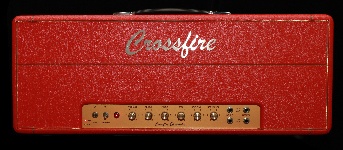






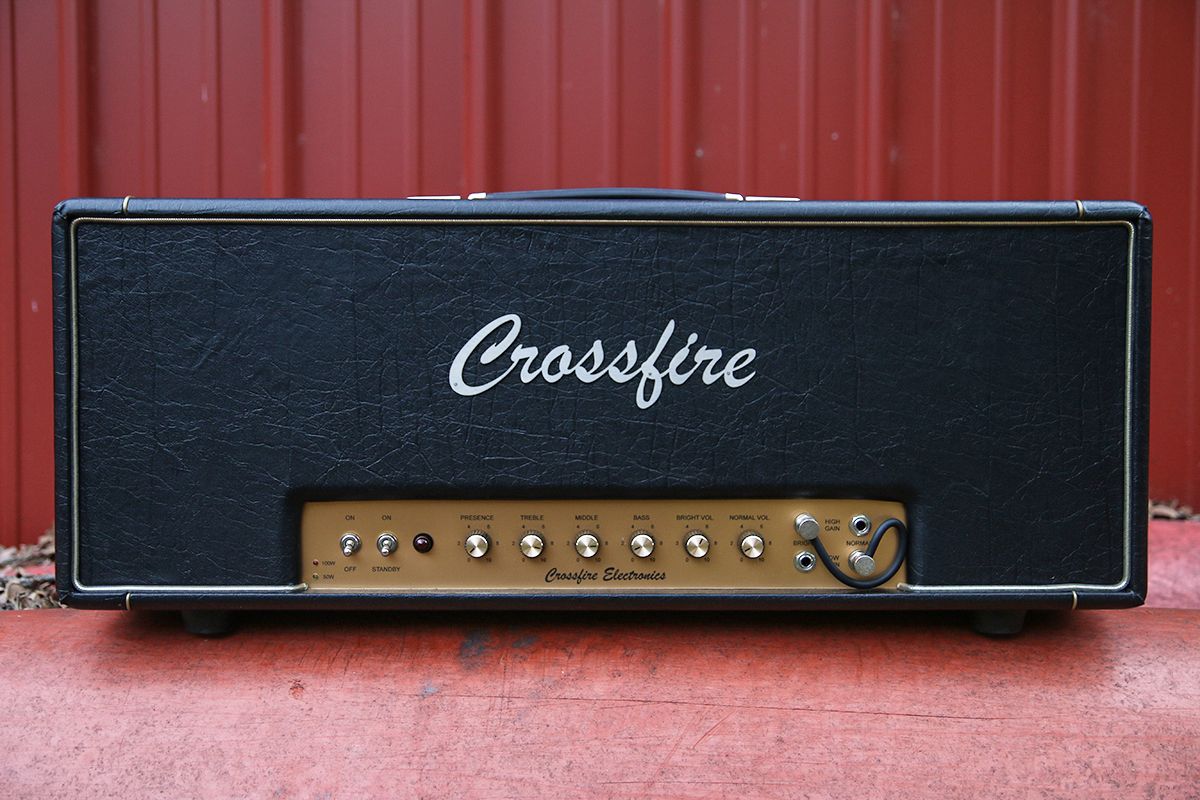

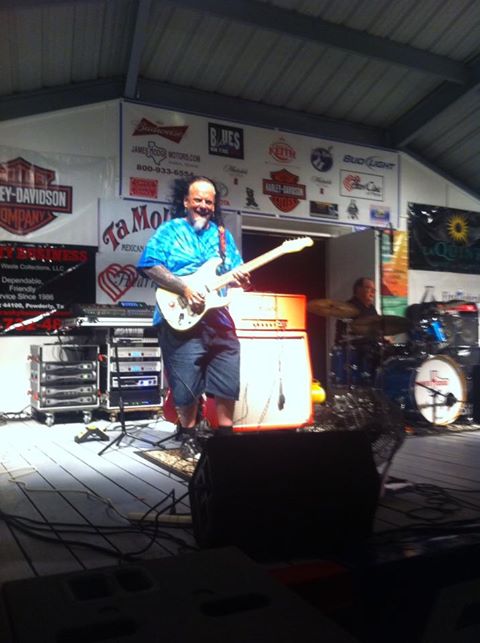
Hover over an image for a description, Single Click to see an image in high resolution. Use browser return arrow to return.
The model CT-1992 is the flagship product of Crossfire Electronics. You must hear this amplifier live to believe it. Listen. Local Blues Musician Oliver White, of The Oliver White Group, commissioned this design. Oliver wanted a replacement for his Marshall Plexi with more power and better sound. He suggested, during the initial discussions, that he wanted an amplifier that was a lot like the rare Marshall Super Bass amplifier but with more power and a better low end. The desire was to have that classic British sound and voicing but not as thin as typical Marshall amps sounded. He also wanted power switching from 50W to 100W so that the same amplifier could be used for both small and large venues. The amplifier was to be basic, rugged and reliable.
The initial design was completed using Electronic CAD software and portions of the design were simulated and tweaked using SPICE simulation tools. A proprietary power switching design was developed along with a bias and control circuit card that is unique to Crossfire designs. A prototype was built that allowed rapid changes to critical circuit parameters and easy change-out of critical components. Over several weeks, Oliver and I arrived at an optimal design that achieved the desired tonal qualities. From this, a production amplifier was built. The result is the model CT-1992 amplifier depicted above.
The remarkable sound quality of this amplifier exceeded our expectations and I decided to make it a standard offering. A second amplifier was built and is available for customer demo use. The demo unit is occasionally loaned to artists for live performances and recording use. Metal band, Kid Liberty, recorded their new album in 2012 using the CT-1992.
This amplifier is also available in a 50W model.
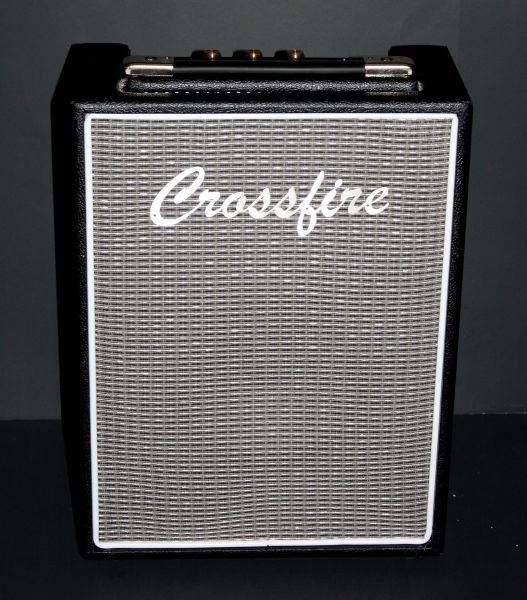



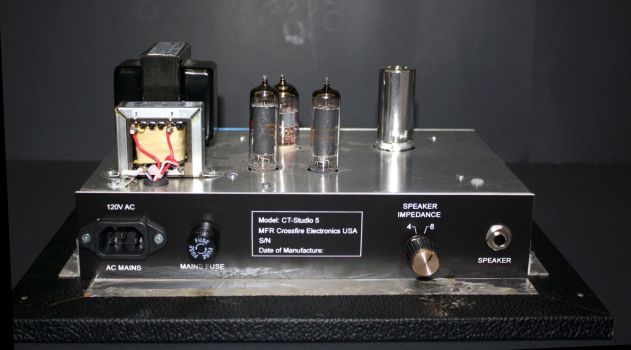
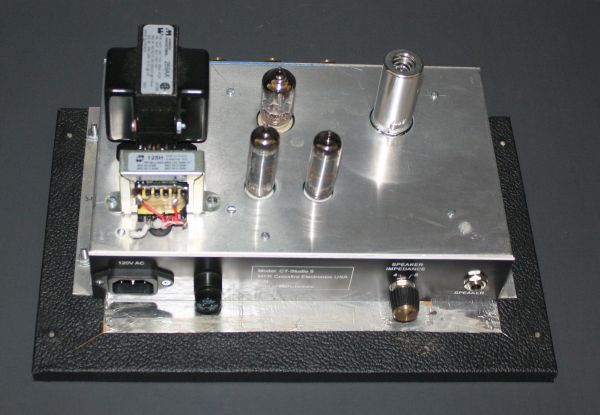
The most requested amplifier has always been a 5 Watt vacuum tube practice amplifier. I have resisted because vacuum tube designs do not scale down well and all other 5 Watt amplifiers that I have tested have been junk. In order to scale down to 5 Watts, most designs use Class A power amplifier stages. I have never been a fan of Class A designs, they tend to distort when driven past half volume. I much prefer a class A-B design like all of the other amplifiers here on my products page. I could, of course, have done a solid state design easily but I pride myself at being a vacuum tube designer. See "Why Vacuum Tubes" link on the front page of this website.
The Studio 5 amplifier is a true Class A-B vacuum tube design of which I am proud. I finally landed on a combination of lower power components from which I could truly create an amplifier that I can put the Crossfire logo on. This little amplifier sounds great.
Come listen to this small amplifier and you will understand why it is a better choice than the offerings from the big names.
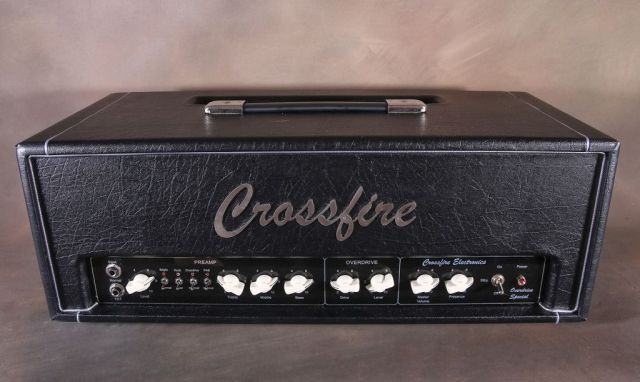


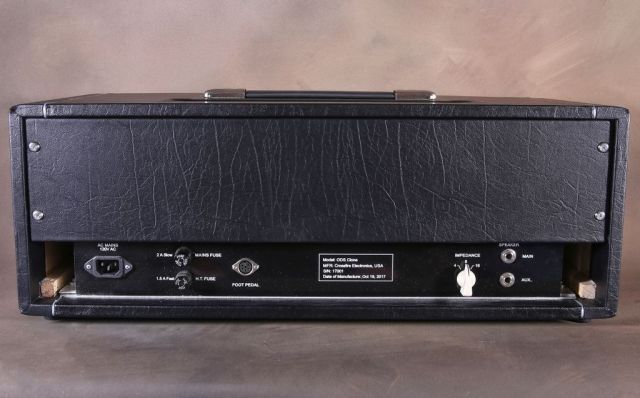
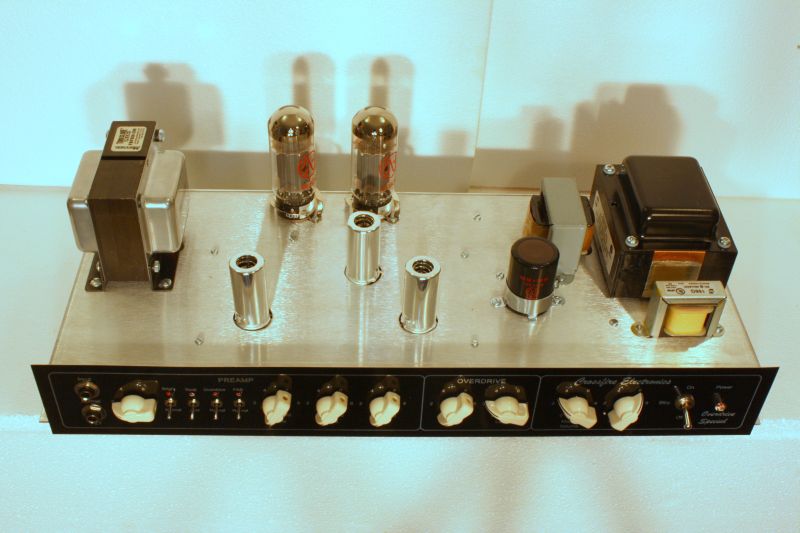
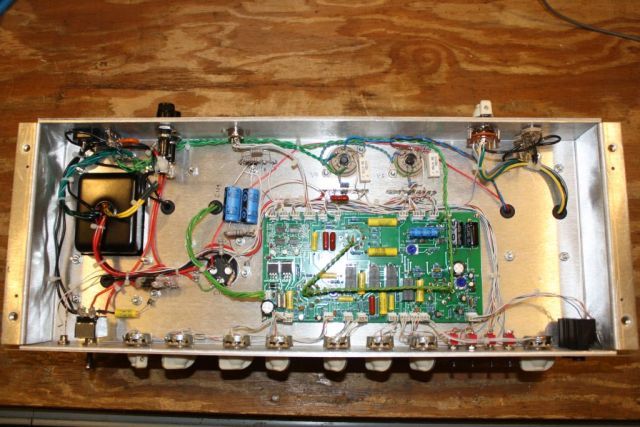
Hover over an image for a description, Single Click to see an image in high resolution. Use browser return arrow to return.
History: In Southern California in the 1960's, Alexander Howard Dumble started constructing unique special amplifiers. His most famous was dubbed the "Overdrive Special" which is commonly known as the Dumble ODS. Many notable musicians (according to Wikipedia) who used his amplifiers were Robben Ford, Stevie Ray Vaughn, Carlos Santana, John Mayer, Eric Johnson and many others. All ODS amplifiers were hand built and were based on modified Fender designs. Many were unique and tailored for the artist customer. It is said that no two were alike. Reportedly, about 250 ODS's were built. Those original amplifiers sell for astronomical sums when they become available. Enough Dumble ODS's have been reverse engineered so that schematic snippets are readily available on the internet. There are hobbyists building various versions of the ODS today and even partial kits are available.
The Crossfire ODS clone is my take on the ODS design. It is based on best publicly available information. Since no true complete schematic of a ODS exists (others have published their own interpretation but these differ from a real ODS in many ways), I have created my ODS clone, simulated it, and developed a proprietary printed circuit board containing the preamplifier and driver circuitry. The result is the Crossfire ODS clone. It truly lives up to the legend.
An excerpt of the Wikipedia description of the Dumble ODS is here.The ODS is a complex amplifier and a difficult one to build. There are relays that control the features and these relays do not lend themselves to traditional point to point wiring techniques. Lead lengths would be excessive so controlling stability, crosstalk and hum would be difficult. Therefore, a printed circuit board (PCB) was developed that contains 90% of the circuitry. Lead length is therefore minimal and noise is controlled. In fact, this is the quietest amplifier that I have ever tested. Even though this amplifier remains true to the Dumble ODS legend, the Crossfire tenets of design were incorprated (See below for Tenets of Design). With these tweaks and the incorporation of a custom PCB, I believe that this is a superior interpretation of the original. The use of a Mercury Magnetics output transformer further enhances the great tone of the Crossfire ODS.
Certain design issues needed to be addressed. Tying together these snippets of available information was a challenge. Power supply design (both low voltage and high voltage supplies), bias supply design, and foot pedal logic and relay control designs were necessary. A characteristic of all Crossfire designs is to stand up to a strong pick attack with no aftertaste, no ringing or muddiness. Have clear response to all chords so that each string can be heard clearly and distinctly even while mixed as part of the overall tone. Another characteristic of Crossfire amplifiers is controlled breakup when driven hard. A design was done, simulated and a prototype built. The design was tweaked and with the help of several local musicians, a final design was arrived at. Notice how clean and un-cluttered the chassis is (see pictures above).
A foot pedal is included that controls three features of the amplifier. These are 1)Jazz/Rock 2)Normal/Overdrive and 3)Preamplifier bypass off/on. When plugged in, the foot pedal overrides the front panel switches. LEDs on the foot pedal and the front panel clearly indicate which features are selected.
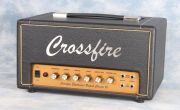
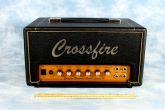

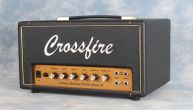
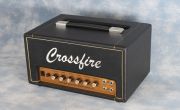

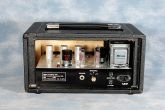

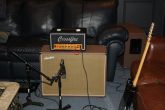
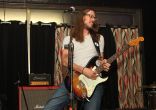
Hover over an image for a description, Single Click to see an image in high resolution. Use browser return arrow to return.
The Crossfire Electronics British Classic 15 head is a British voiced, 15W, studio or small venue amplifier. It has all of the sonic performance of the CT-1992 but in a smaller case and with less output power. It fills the need of studio musicians or those who are simply tired of lugging around a 50 pound amplifier to venues. (It weighs just 19 pounds.) It is a result of months of design and tuning before making it available. This amplifier has strong low end performance with crisp highs. It has a magical sparkle when playing lead through it. Listen. Despite its British voicing, country artists who have played it love the high end sparkle that it has. Although the intended use was for Blues, it is suitable for multiple genres.
This amplifier is punchy and has controlled breakup qualities when driven hard. In a recent demo session with Jake Cox, (The Sideshow Drifters), Jake commented that this amplifier was made for a Telecaster. A characteristic of this amplifier is strong recovery and a lack of muddiness. It is crisp and clear across all chords. When hit with a strong singular pick attack, there is no residual sound, just silence and it's ready to go again with no sagging, ringing or after effects. This results in crisp notes and no overload. All notes are heard, the bass never overloads and masks the highs. It is also compact, rugged and reliable. This amplifier has two preamps, Normal and Bright with independent Volume controls. They may be used by two different guitars at the same time (Rythm and Lead) or they may be bridged for a third mode (Bright Normal) with the supplied bridge cable. Each preamp channel has two inputs, a high gain input and a lower gain input for higher output guitars such as those containing certain humbucker pickups.
You must hear this amplifier to believe it.
This amplifier was designed using Electronic Spice Simulations to optimize the design. A prototype was built and tweaked with input from several local musicians. It is a 5 tube design using classic British style EL84 Pentode output tubes in Push-Pull arrangement. The tone stack is classic British voicing, reminiscent of early Marshall Plexis. A Mercury Magnetics proprietary output transformer is used, setting this amplifier apart from the inexpensive wanna bees. The highest quality components are used through out. The amplifier is hand wired point to point wired for that vintage performance.
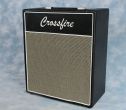
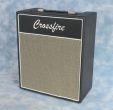

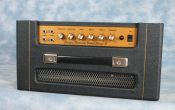




Hover over an image for a description, Single Click to see an image in high resolution. Use browser return arrow to return.
The Crossfire Electronics British Classic 15 combo is a British voiced, 15W, studio or small venue amplifier. It has all of the sonic performance of the CT-1992 but in a combo case and with less output power. This combo unit is electrically identical to the British Classic 15 head but in a cabinet with a Celecstion G12 Greenback speaker. It fills the need of performing musicians who want an all in one combination unit that has a smaller size but has the sound of much larger amps. It is a result of months of design and tuning before making it available. This amplifier has strong low end performance with crisp highs. It has a magical sparkle when playing lead through it. Listen. Despite its British voicing, country artists who have played it love the high end sparkle that it has. Although the intended use was for Blues, it is suitable for multiple genres.
This amplifier is punchy and has controlled breakup qualities when driven hard. A characteristic of this amplifier is strong recovery and a lack of muddiness. It is crisp and clear across all chords. When hit with a strong singular pick attack, there is no residual sound, just silence and it's ready to go again with no sagging, ringing or after effects. This results in crisp notes and no overload. All notes are heard, the bass never overloads and masks the highs. It is also compact, rugged and reliable. This amplifier has two preamps, Normal and Bright with independent Volume controls. They may be used by two different guitars at the same time (Rythm and Lead) or they may be bridged for a third mode (Bright Normal) with the supplied bridge cable. Each preamp channel has two inputs, a high gain input and a lower gain input for higher output guitars such as those containing certain humbucker pickups.
You must hear this amplifier to believe it.
This amplifier was designed using Electronic Spice Simulations to optimize the design. A prototype was built and tweaked with input from several local musicians. It is a 5 tube design using classic British style EL84 Pentode output tubes in Push-Pull arrangement. The tone stack is classic British voicing, reminiscent of early Marshall Plexis. A Mercury Magnetics proprietary output transformer is used, setting this amplifier apart from the inexpensive wanna bees. The highest quality components are used through out. The amplifier is hand wired point to point wired for that vintage performance.


Single Click on a thumbnail to see an image in high resolution
In 2008, Crossfire Electronics began producing a hand built replica of the Classic Bassman. We set out to reproduce this classic but make it better. It is a faithful replica of the original Fender Model 5F6A being 95% electrically identical. The Crossfire design utilizes the 4 x 10 speaker configuration introduced in 1958 as the optimum speaker configuration in a more modern Black cabinet with Silverface Grille and chrome front panel. It utilizes Weber AlNiCo speakers that produce almost exactly the performance of the original Jensen speakers of the era. In addition, certain critical components used in the Crossfire implementation are of higher quality than the original Fender amplifiers. The most significant of which is the Output Transformer. Crossfire utilizes Mercury Magnetics output transformers exclusively. These transformers are superior to the original Stancor Transformers used in the Fender models in several ways. They have higher quality Iron laminations, improved winding techniques and a larger, heavier core. These improvements result in lower harmonic distortion, less crossover distortion (due to lower Hysteresis losses), higher efficiency and better frequency response. The bass response is 20 hZ lower than the reproduction Fender Bassman. The Crossfire 5F6A also uses Groove Tubes matched 6L6 GE tubes in the output stage that are hand selected for best performance in Blues applications. After construction, each amplifier is hand tuned, Bias and feedback are optimized. A solid state bias circuitry is employed for precise, stable output tube bias unlike the original Bassman.